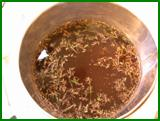
This weeks Pestwatch report, issued by Dow AgroSciences and ADAS, shows an increase in egg-hatch in East Anglia and Lincolnshire and the start of egg-hatch in Yorkshire. No plant invasion by the larvae has been detected as yet and there is still time to apply an effective egg-hatch soil insecticide such as Dursban WG to at-risk crops.
Weekly information on Wheat Bulb fly egg-hatch can be accessed on the web at http://www.dowagro.com/uk/cereal/pest.htm and farmers and advisors are encouraged to log on in order to help them assess the risk to their crops and so optimize egg-hatch timings, thereby complying with good Stewardship practices. This week’s Pestwatch report indicates that Wheat Bulb fly egg-hatch in Suffolk had increased to 20%, in Cambridgeshire/Hertfordshire on mineral soils it was 11.9%, in Cambridgeshire on organic land 18.8%, in Lincolnshire on organic soils 14.6% and Yorkshire on mineral soil 1.3%. Pestwatch will be monitoring egg-hatch on a weekly basis up until mid-February.
"With Wheat Bulb fly egg-hatch well underway across the country, it is worth considering an application of Dursban WG (chlorpyrifos) at the first available opportunity , particularly to crops that are considered to be vulnerable. Such crops include late drilled crops, backward or thin crops or crops that are struggling. In these situations tiller survival is very important. This year, with the highest recorded Wheat Bulb fly eggs being detected since 2004 and the fourth highest since monitoring began in 1984, growers should be ready to take action," says Sarah Hurry of Dow AgroSciences.
"Dursban WG is an effective soil insecticide and should be applied at egg hatch at 1 kg/ha in 200-1000 litres of water. It will remain active in the soil for at least six weeks, which means that most larvae will be controlled as they hatch over a longer period of time. Two applications of Dursban WG at 1 kg/ha is permitted on crops before GS 39. A further 0.6 kg/ha can still be applied for Orange Wheat Blossom Midge after GS 39 where necessary," she says.
For further information, please contact the Dow Technical Hotline on 0800 689 8899.
Dursban WG (75% w/w chlorpyrifos formulated as a Water Dispersible Granule) is recommended for the control of Wheat Bulb fly as well as Leatherjackets, Frit fly and Wheat Blossom Midge. For Wheat Bulb fly, two applications at dose rates of 1 kg/ha maybe applied up until flag leaf sheath extending (GS 39). It is packed in a 1 kg pack.
®Dursban is a trade mark of Dow AgroSciences LLC.
